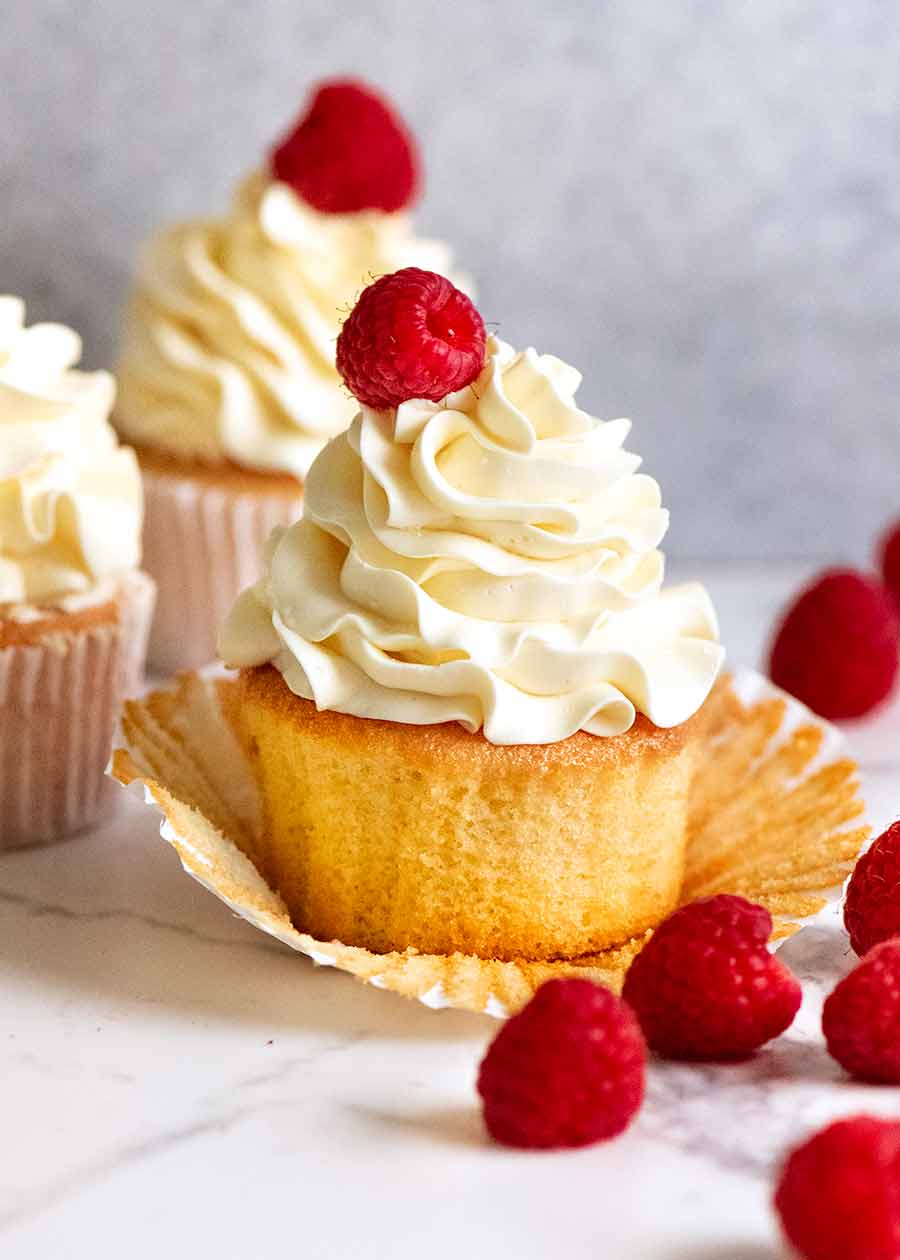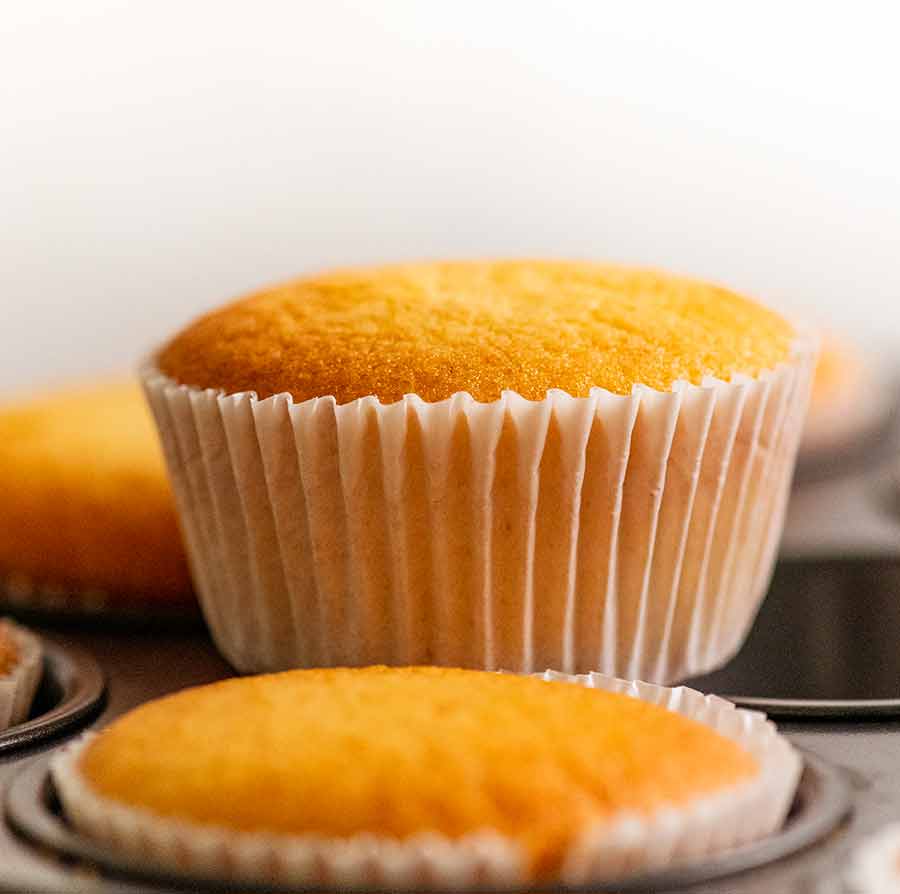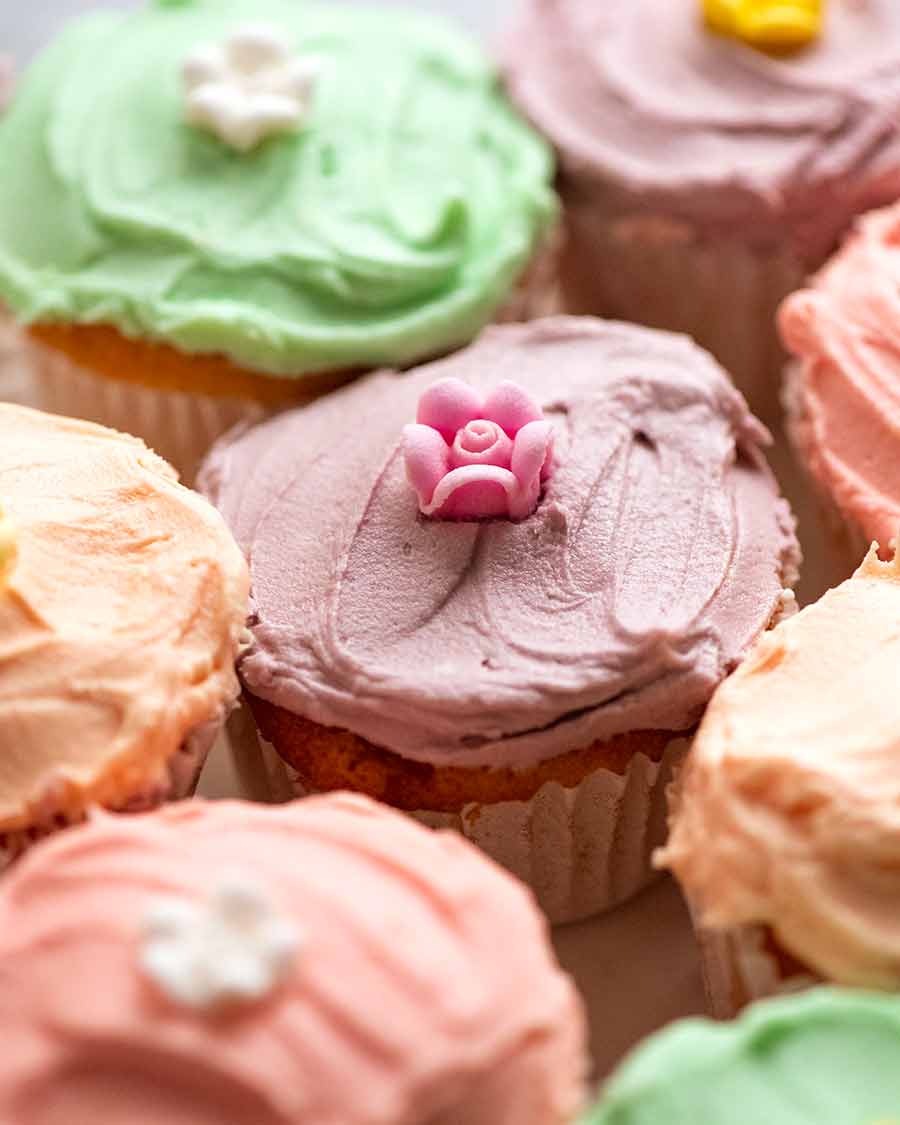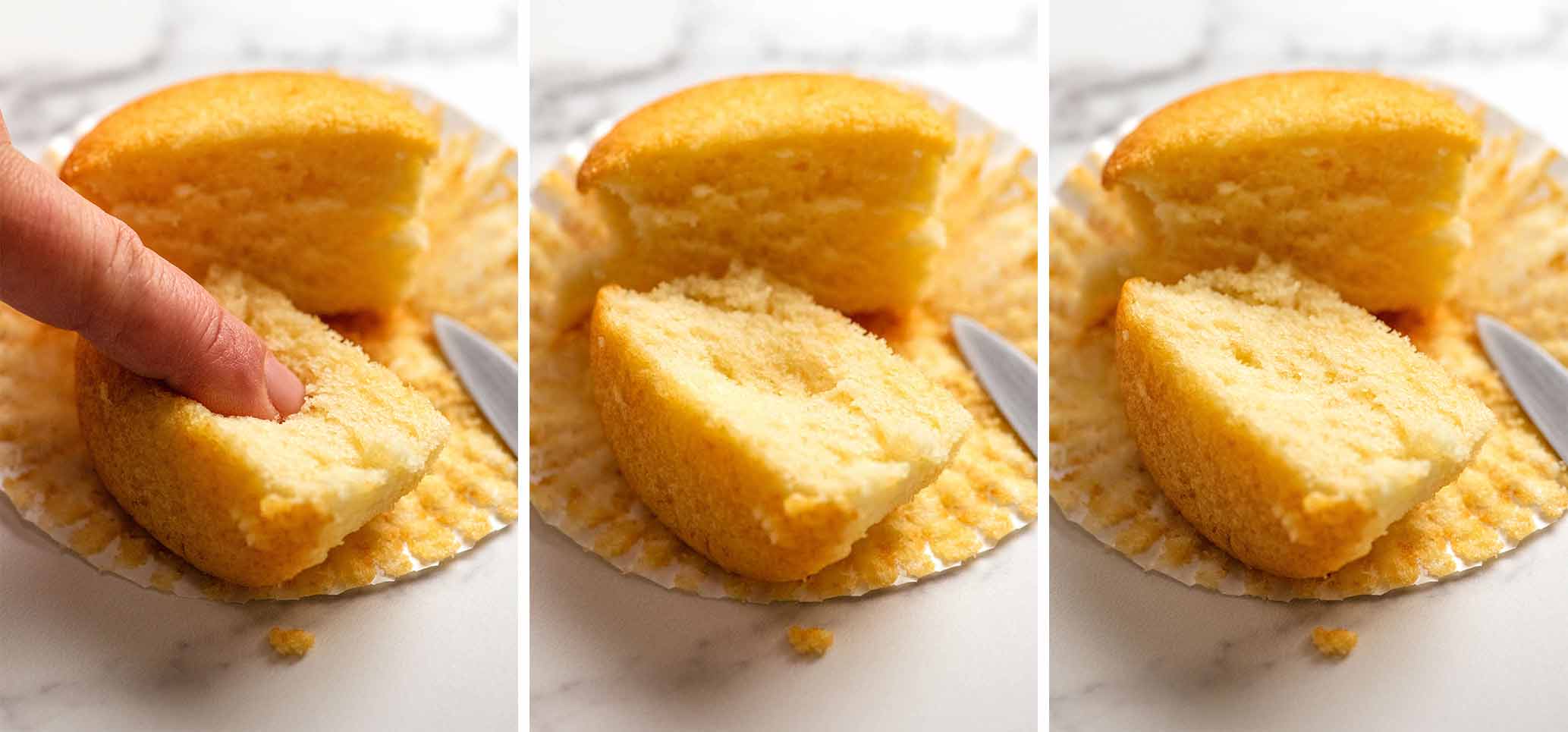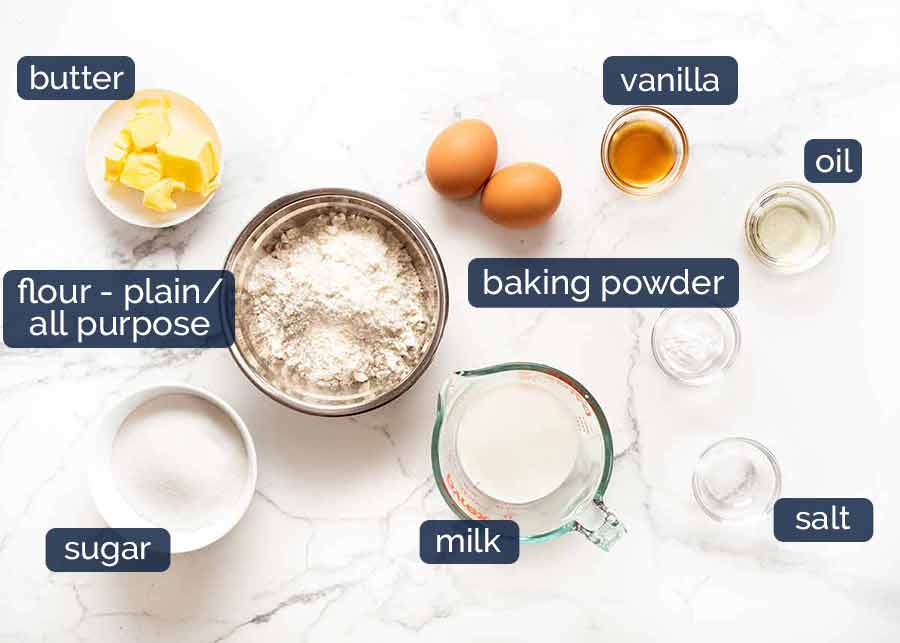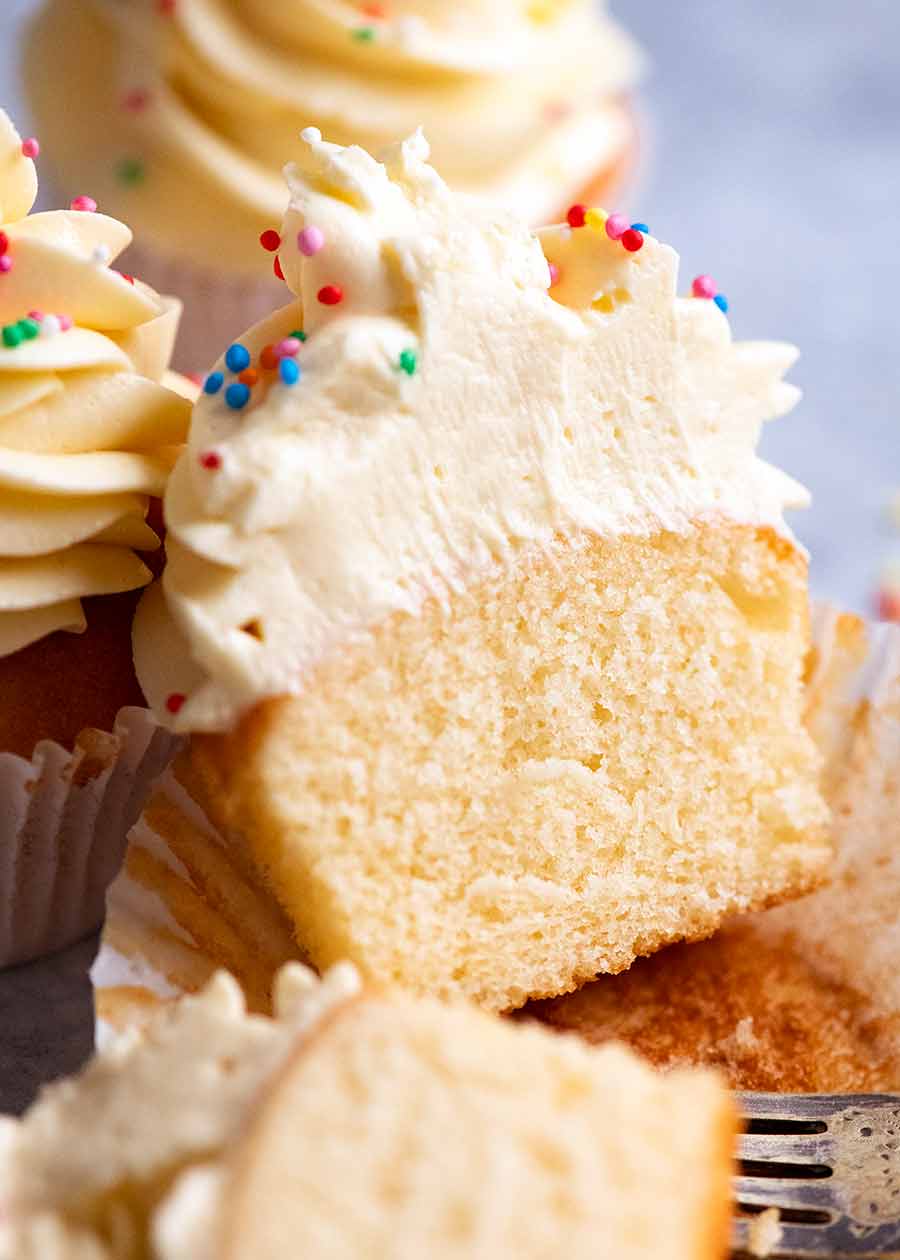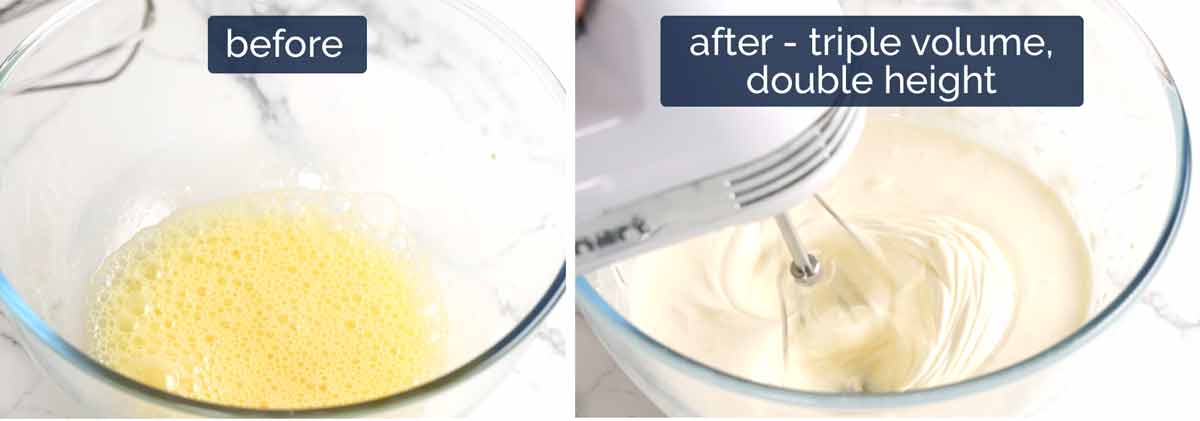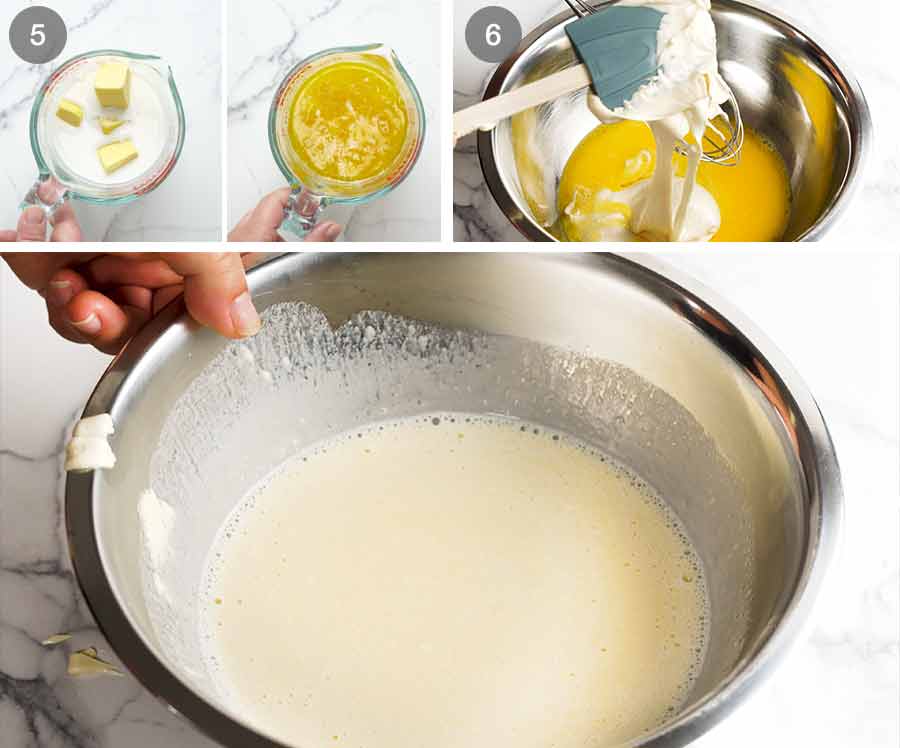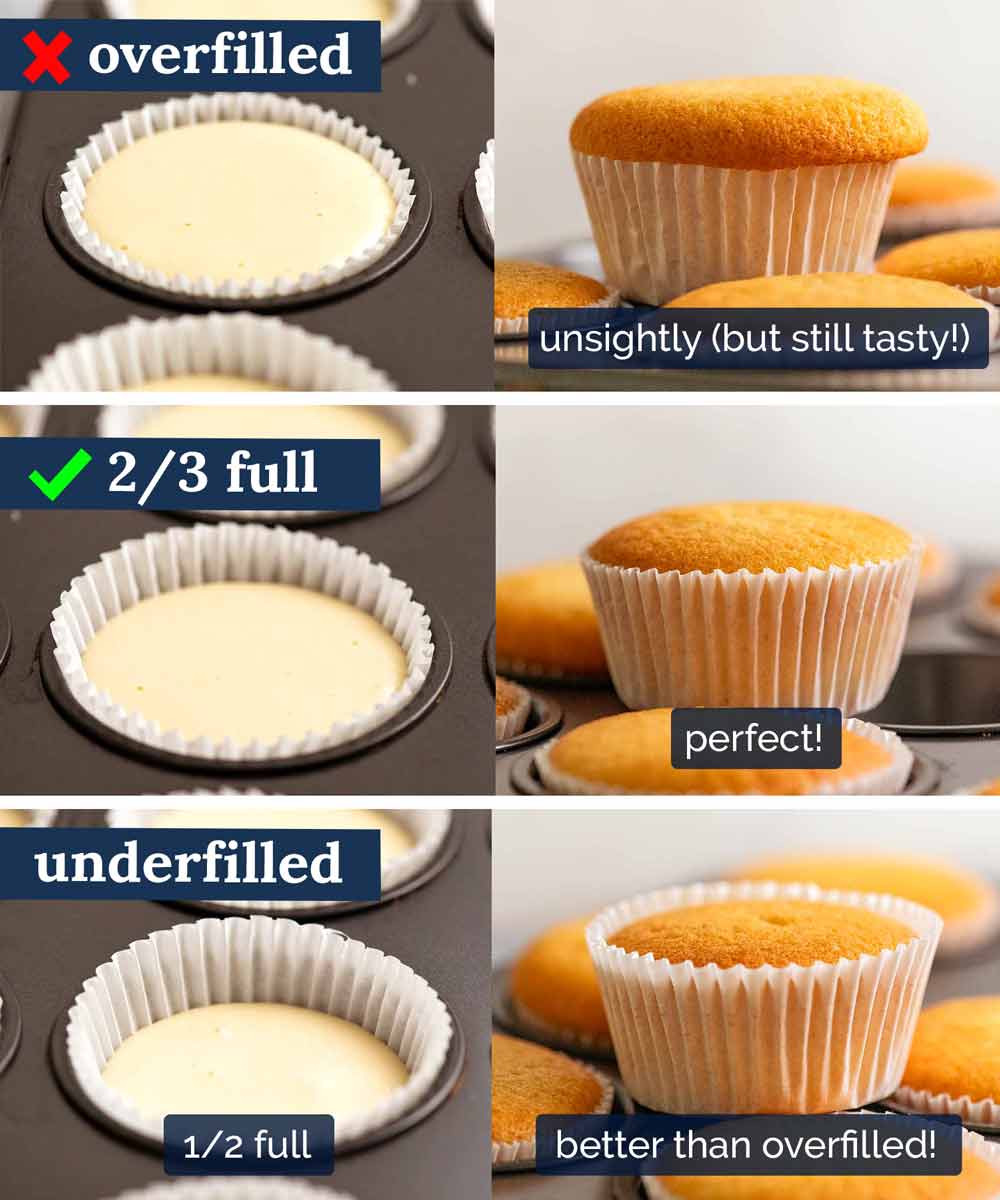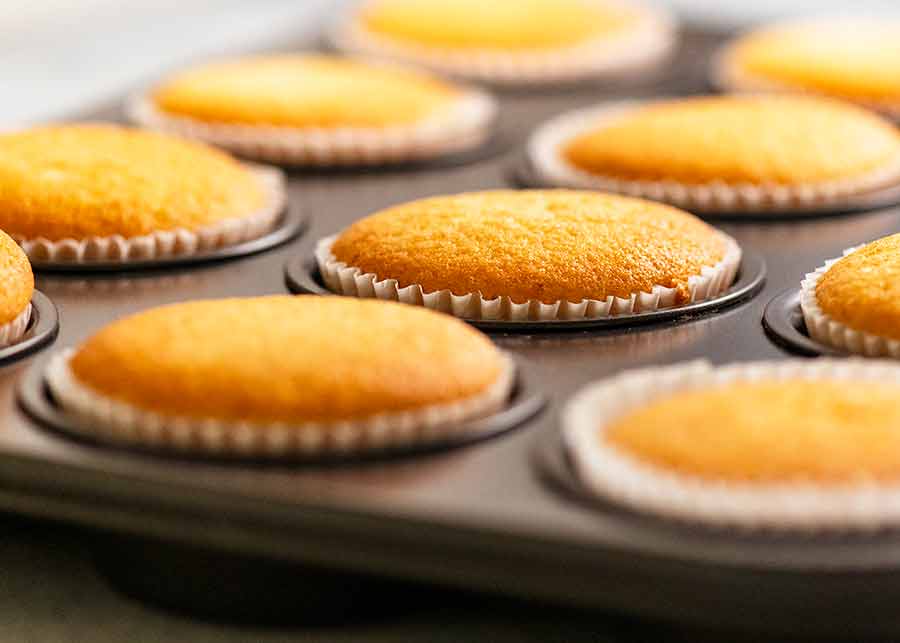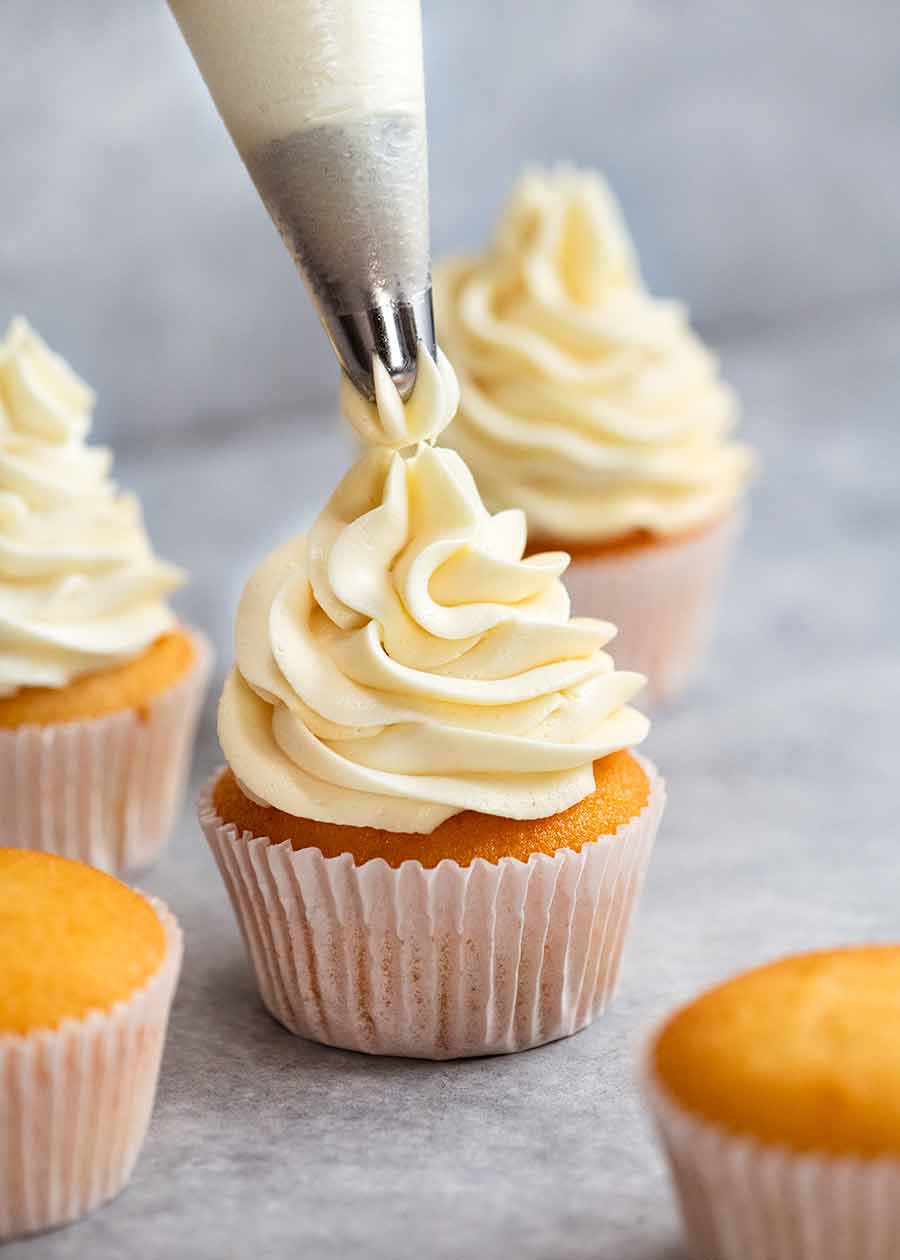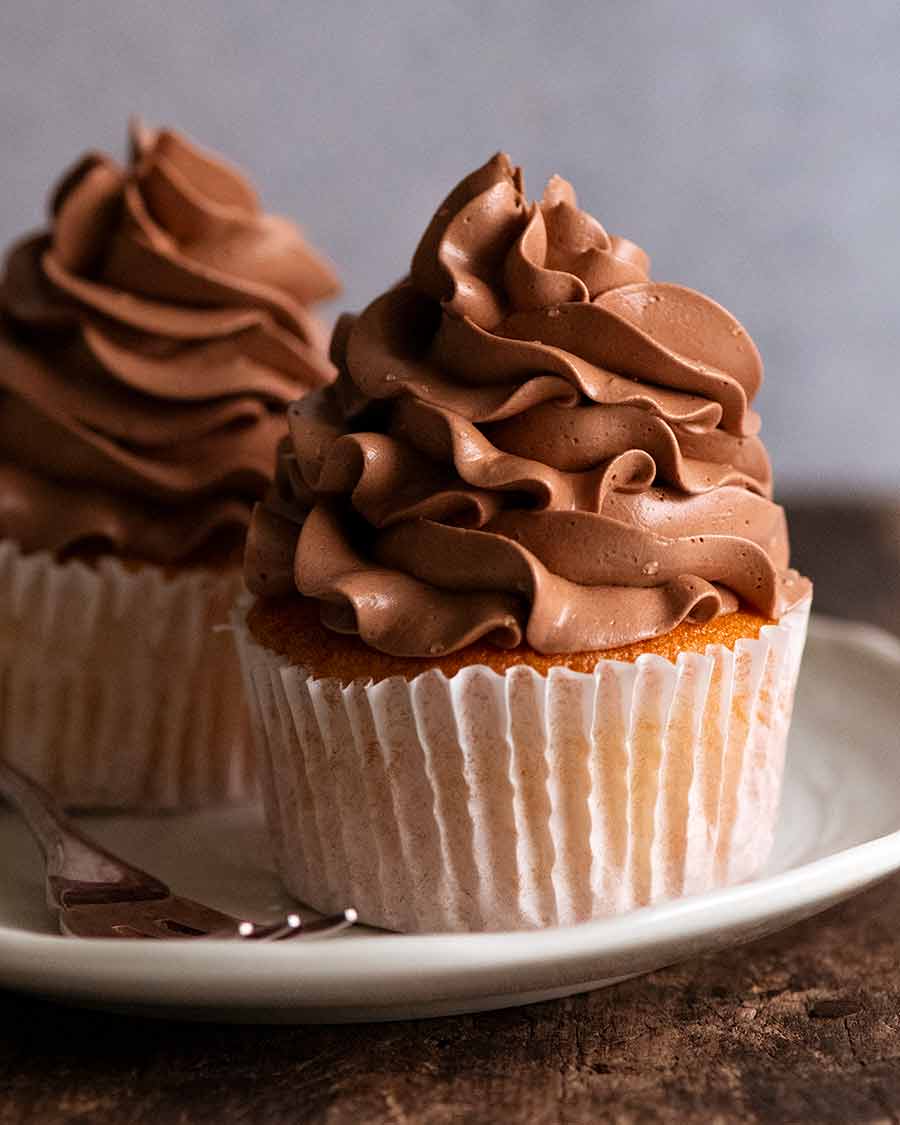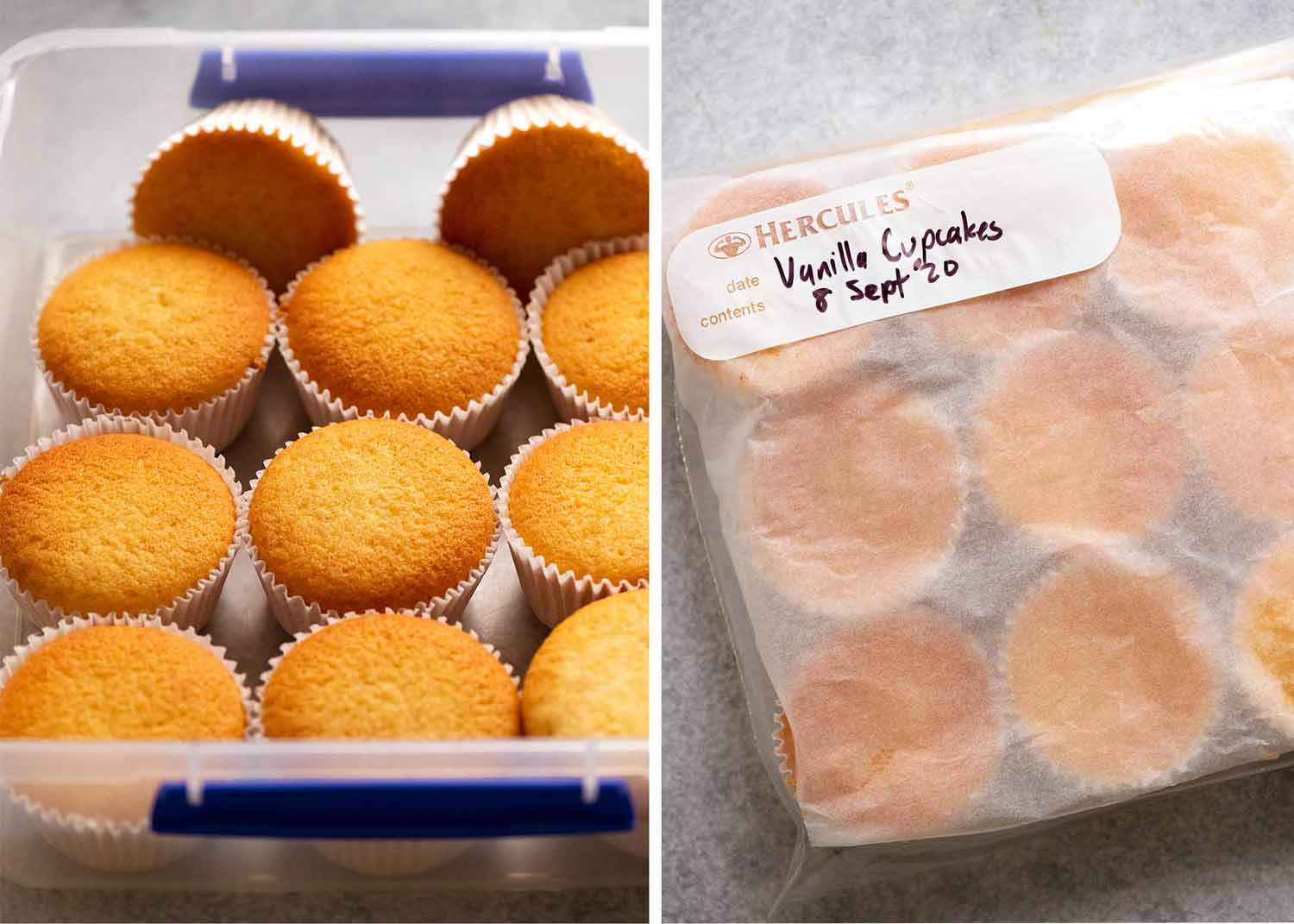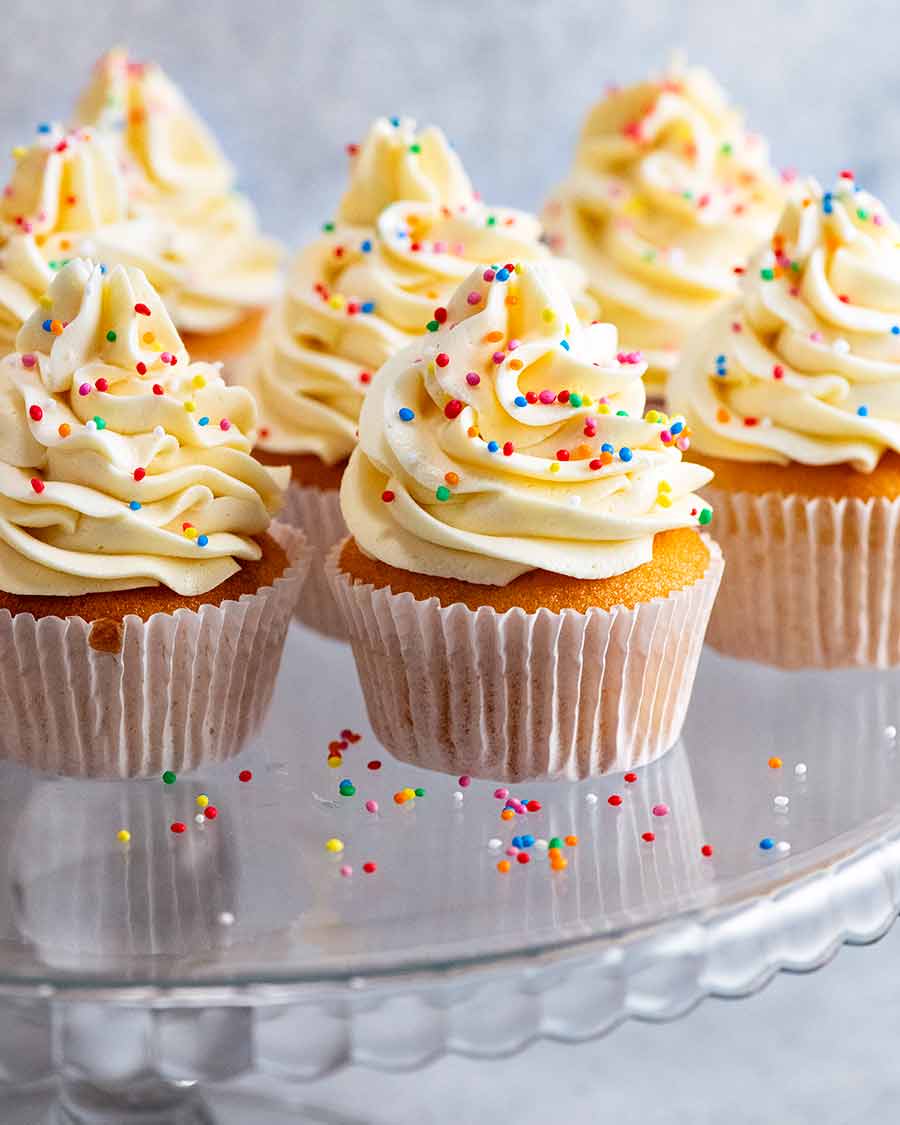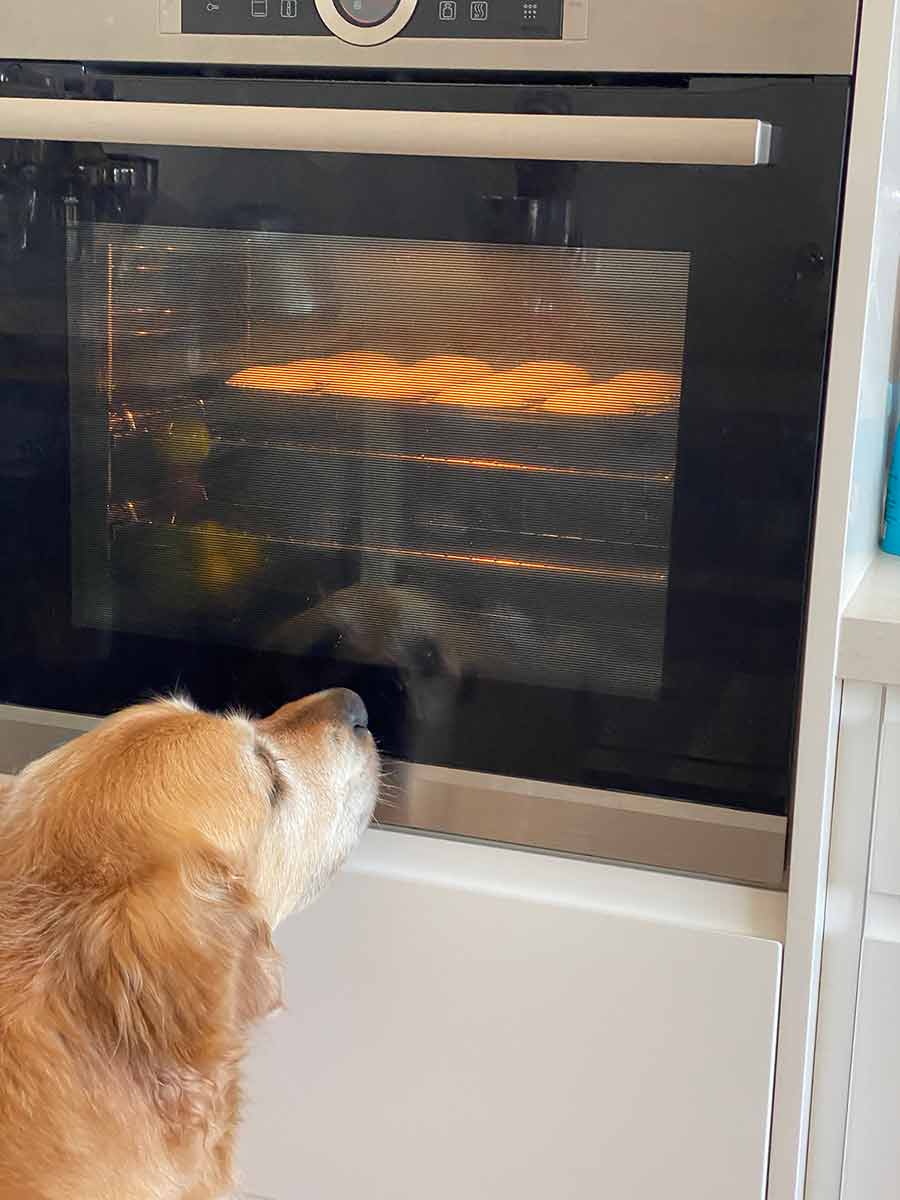No secret ingredients. Just a secret Japanese baking technique applied to classic butter cupcakes ingredients. It’s like…. magic! ✨ It’s notoriously hard to find a really good, classic cupcake recipe. Many promise game changing techniques, but all too often they fall short. So why should you believe me when I say this is the last Vanilla Cupcake recipe you’ll ever use? Because this is already a tried and proven recipe made using the batter from my Vanilla Cake. But don’t believe me. Browse the reader feedback! “Holy mackerel, this cake is amazing.” “…this is the sponge I’ve been looking for my whole life. It’s so perfect I almost wept with sheer joy.” “Wow wow wow!” (Also, the directions to make these cupcakes are hidden deep in the Vanilla Cake recipe notes, and an astonishing number of readers have already made these cupcakes!)
These Vanilla Cupcakes are …..
Soft and fluffy, with a plush velvety crumb; Infused with elegant buttery and vanilla flavours; Perfectly shaped with a sweet golden dome; Much more tender than your usual run-of-the-mill cupcake recipes; Less sweet than typical cupcakes; Safer to make than typical “cream butter and sugar” recipes; and Stay fresh and moist for 4 days (minimum).
Sydneysiders may be interested to know that these Vanilla Cupcakes are just like the cupcakes at My Little Cupcake in Neutral Bay, a hidden gem with a cult following which (10 years on) I still say trumps the famous Magnolia Bakery in New York. Ballsy! Call me on it – try these cupcakes! 😂
Freshness evidence!
Here’s my attempt to show you how these cupcakes stay incredibly fresh. The cupcake below is 4 days old. If it was dry and stale, the crumb would not bounce back like it does, it would just tear and stay indented. And if it was dense, I would not be able to prod it at all! This recipe uses classic cupcake ingredients but with Japanese techniques applied for the softest, plushest cupcakes you’ll ever make! This post goes into detail on the steps to give bakers of all levels the confidence they need to make this. If you’re an experienced baker, you may wish to skip ahead to the recipe or recipe video. (Or Dozer 😂)
What you need for these magical Vanilla Cupcakes
Here’s what you need for these Vanilla Cupcakes. Everyday pantry ingredients! Don’t waste your money on cake flour – these work better with plain/all purpose flour!
Plain flour (aka all purpose flour) – there’s a widely held misconception that cake flour is the secret to tender, fluffy cupcakes. This is simply not true. These cupcakes actually come out better using plain flour rather than cake flour. You can taste the vanilla and butter slightly better, the crumb is slightly more velvety AND it keeps ever so slightly better too. Cake flour works very nearly as well so if that’s all you’ve got, it can be used. Do not substitute with self raising flour or gluten free flour; Eggs at room temperature, not fridge cold – whipped to aerate, these are key to make the cake extraordinarily light and fluffy. You don’t get an eggy flavour. It’s important for the eggs to be at room temperature as they whip better; Baking powder – not baking soda (bi-carb), it doesn’t rise as well. This is our safety net, extra helping hand to make the cake rise; Milk, full fat – just plain cow milk. Low fat works as well but rises marginally less. Do not substitute with non dairy milk or buttermilk; Sugar – best to use caster / superfine sugar if you can because it dissolves better in the eggs. But regular / granulated sugar works just fine too – you may just end up with slightly more (tiny!) speckling on the surface (from residual undissolved sugar grains. Barely visible to ordinary people – I’m just particular! Oil – just 1 1/2 teaspoons adds a noticeable hint of extra moistness, especially on Day 4, without weighing down the cupcake in the slightest; and Vanilla extract – the best you can afford. Imitation will work just fine, but the flavour isn’t as pure or real. I use Queen Vanilla Extract. Don’t waste your money on vanilla beans or vanilla bean paste – it’s not worth it for cupcakes.
How to make Vanilla Cupcakes
This cupcake recipe is straightforward and is in fact less risky to make than the typical recipe that starts with “cream butter and sugar….”. That single step is open to wide interpretation and is the single biggest cause of baking fails – especially cupcakes. The smaller the cake, the more prone to errors… but not with this recipe!
Beat eggs until fluffy
- Use a handheld beater instead of a stand mixer – for small batch batters like this, it comes together better using a handheld beater you can move around the bowl rather than a large stand mixer bowl. If using a stand mixer, you’ll need to scrape down the sides and base well to ensure the batter comes together evenly. There is no excess batter in this recipe!
- Whip the eggs and sugar – Beat the eggs with sugar for a whole 7 minutes until thick and glossy, it changes from yellow to white, and tripled in volume (just over double depth in the bowl). The aeration created during this step is key for a soft, fluffy crumb. This is a technique borrowed from Japanese sponge cakes, world renowned for being the fluffiest in the world! Here’s what it looks like before and after beating:
Gently fold in dry ingredients
- Whisk together the flour, baking powder and salt.
- Gradually add the flour mixture into the egg mixture in 3 lots, mixing for just 5 seconds on Speed 1 in between. This should make the flour just incorporated – don’t worry if there are some streaks on the bowl not mixed in. Key here is minimum mixing!
Whisk together some batter with hot milk (tempering)
- Melt butter and heat milk – use a microwave or stove to heat milk with the butter until it melts. HOT milk helps with rise for these cupcakes – I was dubious so I tried the Vanilla Cake with cooled melted butter in milk and found it did not rise as well.
- Mix some batter into hot milk (tempering) – this serves two purposes: a) bring down the temperature of the hot milk so it won’t “cook” the eggs (ie. tempering); and b) it lightens up the density of the hot milk (see above – it becomes foamy) so it blends together faster when added to the rest of the whipped egg mixture. Remember, minimal beating is key so we don’t knock out the cake-rising-bubbles we created in Step 2.
Finish batter & fill cupcake liners
- Slowly pour milk mixture back into whipped eggs over 15 seconds while beating on the lowest speed. Scrape down sides of bowl, then mix for 10 seconds – the batter should now be smooth;
- Fill cupcake liners with batter – I find the easiest way to do this is with an ice cream scoop with a lever. The standard size is 1/4 cup which is actually the perfect quantity for cupcakes!
Why can overfilling make cupcakes sink? Because the sponge gets support from the liner – it climbs up the paper as it rises. Once it reaches the top, overflows or rises above the cupcake liner, it no longer has the support and this can cause the middle to sink.
Bake 22 minutes
- Bake 22 minutes until golden and a toothpick inserted into the centre comes out clean.
- Remove after 2 minutes – Rest for just 2 minutes to let them cool slightly, then get them out of the muffin tin asap otherwise they will continue cooking and may overcook. Cupcakes are small – they overcook easily!
This is what your cupcakes will look like – beautifully golden with a sweet little dome. Not too rounded – flat enough for tall swirls of frosting to sit. But not too flat – so it looks pretty even just dusted with icing sugar (powdered sugar) or drizzled with a glaze.
Best frosting for cupcakes
The best frosting for cupcakes comes down to personal taste and, more often than not, storage, shelf life and transport logistics. There’s a wide variety of frostings pictured throughout this post – I’ve noted the frosting used in the caption under each photo. My frosting library is currently sadly lacking (I’m working on it!) but here’s a few options for you:
Vanilla Buttercream – the classic and easiest of all whipped butter based frostings. Use the recipe in my Vanilla Cake (recipe will frost 12 cupcakes with tall swirls, or 24 frosted with a knife like the pastel coloured cupcakes at the top of this post); My Secret Less-Sweet Fluffy Vanilla Frosting (below) – far less sweet and rich than buttercream, pipes like a dream, and 100% smooth. It’s like a really fluffy buttercream / dense whipped cream But unlike whipped cream which deflates in the fridge within hours, this Fluffy Frosting holds its form for days! Swiss Meringue Buttercream – many people consider this the superior version of traditional buttercream. Made using cooked egg whites whipped into a meringue, this is more technical to make than classic buttercream and yields a thick-yet-light silky smooth frosting that’s suitable for piping as high as you want, and holds its form for days. I haven’t shared a recipe yet but have used this recipe by a website called Sugar Spun Run in the picture below.
Best way to store cupcakes
Being the little cakes that they are, cupcakes are prone to easily drying out if not stored correctly.
Airtight container, stat! Don’t leave cupcakes out on the cooling rack longer than necessary. Once cool, get them in an airtight container as soon as possible; Mild weather: Naked cupcakes are best stored on the counter rather than in the fridge – at 25C/77F (highest temp), my cupcakes last for 4 days without loss of freshness. Use a cake dome with heavy glass lid (to ensure no air gets in) or an airtight container; Hot weather: Any hotter, store in the fridge in an airtight container BUT ensure you bring to room temperature before serving (naked cupcakes will take 30 minutes to come to room temp). The butter in the cupcakes firms up in the fridge, so cold cupcakes seem dry. Also, cold cakes just aren’t very pleasant! Freeze as follows: place sheet of baking/parchment paper on cupcakes, then wrap in cling wrap or place in single layer in ziplock bags. With paper in between, you can stack. Place in an airtight container (for extra security / avoid freezer smells) then freeze. To use, thaw in the fridge overnight (still in container) then bring to room temperature before serving; Iced / frosted cupcakes need to be stored the way the frosting needs to be stored. Most butter, cream cheese and cream based frostings need to be refrigerated. Follow the storage directions on the recipe you use. Then take cupcakes out of the fridge before serving; No direct contact with cling wrap: Do not cover naked cupcakes with cling wrap – the surface will get tacky on Day 2 and the cling wrap will stick so when you take it off, it rips the surface off. 😩 You must cover the surface with baking paper/parchment paper before using cling wrap; and Do not stack naked cupcakes on top of each other – for same reason as above.
TIPS to nail the cupcakes – Every. Single. Time!
- Read the recipe from start to finish before you start. You can shortcut reading for my quick ‘n easy dinners, but for baking, read first then start!
- Follow the recipe steps in the order listed – don’t get sassy and try to do things ahead or leave things until later. For example, if you melt the butter and heat the milk way in advance and it’s too cool by the time you use it, the cupcakes won’t rise as well;
- Once you start, don’t stop until the cupcakes are in the oven – this is because the batter in this recipe relies on the aeration of whipped eggs. If you leave the batter lying around, the bubbles will deflate and your cupcakes won’t rise as much as they should (they will still rise from the baking powder, just not as much). So if your chatty Aunt Marge calls while you’re mixing the batter, let it go to voicemail!
- Make sure your baking powder is still good – if you do everything right and the batter looks like it does in my video, but your cupcakes don’t rise, the culprit is probably your baking powder. Even if it’s not past the expiry date, if not stored in a cool dry place, or if “someone” left the lid off for days, it can lose rising power. To check if your baking powder is still good, place 1/2 teaspoon in a bowl and pour over boiling water. It should immediately bubble energetically. If not, it’s dead – chuck it! 5. Handheld beater instead of stand mixer – While for Vanilla Cake, I recommend using a stand mixer for ease, for these cupcakes, it’s the other way round. With this smaller batch batter, it’s easier to make using a handheld beater because the ability to move the beater around the bowl makes the batter come together easily with less bowl scraping. However, you can use a stand mixer if you prefer. Just be sure to regularly stop and scrape down the sides AND base of the bowl using a rubber spatula. There’s no spare batter when only making 12 cupcakes!
- Eggs at room temperature – these will fluff better and faster, leading to fluffier cupcakes. It’s easy to warm up fridge cold eggs – just leave in warm water for 5 minutes. What’s a room temperature egg? Pick up the egg. Fridge cold? Too cold. Cool but not cold? That’s ok. Very warm? Hopefully not – unless they just came out of a chicken!
- De-chill icy cold mixing bowls – run them under warm tap water then dry before using. Not hot tap water – just warm. Why? Eggs aerate faster and better when slightly warm. Cold bowl will lower temperature of eggs. This is a general useful baking tip to apply on days when it’s 17°C – eg softened butter creamed in an icy cold bowl will make it firm up; and
- Don’t substitute ingredients unless I specifically say you can in the recipe notes. Regular readers know that I’m very flexible with most of my savoury meals. But with baking, I get stern – because I want your cupcakes to work!
Vanilla Cupcakes – Recap!
PHEW! That is a LOT of information for these seemingly innocent looking little cupcakes! So just to recap the key points:
This recipe yields cupcakes with a professional bakery-style crumb that are more tender, fluffy and moist than your usual recipes; This is done by applying Japanese baking techniques to typical Western cupcake ingredients; The cupcakes stay fresh and moist for 4 days which is an exceptional shelf life for cupcakes; Check to ensure your baking powder is still good (see recipe Note 2); Follow the recipe steps in the order listed, do not jump around; Once you start making the batter, do not stop until the cupcakes are in the oven; and Most importantly, figure out how you’re going to deliver a freshly made cupcake to me. I’m done with cupcakes for a while. Someone make them for ME!😜
Especially for those who have been in pursuit of the perfect cupcakes all their lives, I hope you try, love and treasure this recipe as much as I do. For me, the biggest upside is that they’re still like freshly made on Day 4. Because every single other recipe I’ve tried were always disappointingly stale the next day. – Nagi x
Watch how to make it
Life of Dozer
It is a good thing that oven door is heatproof, otherwise he’d scorch his little nose!
